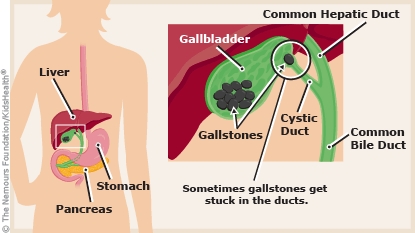If gallstones are causing pain or other problems, health care providers can treat them so your child feels better.


The gallbladder is a small organ just below the liver in the top right of the belly. It stores bile, a fluid produced by the liver to help digest fat in the foods we eat.
Sometimes, material in the bile sticks together and forms hard, pebble-like objects called gallstones. There are two main types of gallstones: those made from cholesterol and those made from bilirubin (a pigment made by the breakdown of red blood cells). Gallstones can happen in kids who have sickle cell disease or other conditions, or who are receiving certain treatments.
Many people who have gallstones don't have any symptoms. But if a gallstone gets stuck going out the opening of the gallbladder, a person may have pain in the top or the top right of the belly, below the right shoulder blade, or in the back. The pain may get worse after eating fatty foods. Someone with gallstones also might have nausea or vomiting.
The health care provider may have used blood tests and imaging studies (like an ultrasound or CT scan) to determine that your child has gallstones.
Sometimes, small gallstones leave the body on their own, and those that do not cause symptoms or problems might not need treatment. But gallstones that cause symptoms often need to be treated with gallbladder-removal surgery. After surgery, gallstones will not return. Sometimes, medicine is used to dissolve gallstones made of cholesterol, but it can take years to work and new gallstones can still develop after treatment.


Your child:

Your child:

Kids who have had gallstones sometimes get them again, and kids who didn't have symptoms from previous gallstones may develop them. Contact your health care provider if symptoms appear.